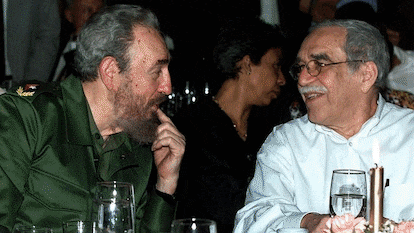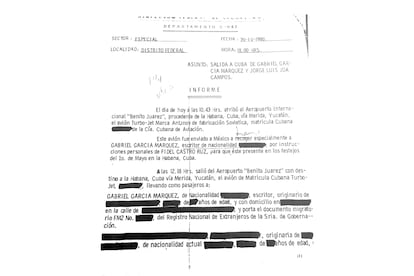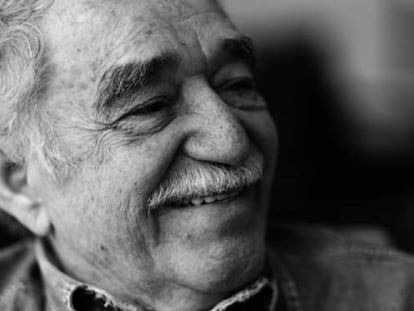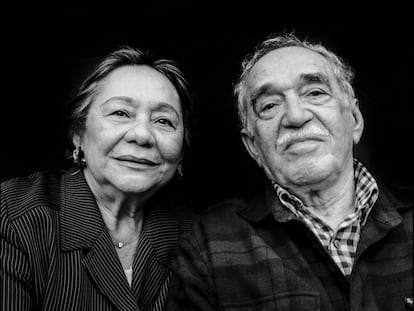When Gabriel García Márquez was investigated over his links to communism
EL PAÍS has seen declassified files from the DFS agency, which kept tabs on the Nobel laureate starting in the late 1960s, when he was at his most politically active


The first book that Gabriel García Márquez gifted to Fidel Castro was Dracula. It was the mid-1970s and the Cuban leader, engaged in the war in Angola, had admitted to his friend that he barely had time to read. Like a kind of literary pusher, the author continued to provide Castro with bestsellers, easy reads to provide a little rest from the revolution. In exchange, Castro became a tough editor of García Márquez’s early manuscripts. In Chronicle of a Death Foretold, inspired by a real event, he had the author change even the caliber of the weapons in the novel.
The friendship had begun earlier, the fruit of a dual fascination – of the journalist García Márquez for the trappings of power and Castro’s for the great intellectuals – but it was always steeped in literature, to the extent that García Márquez signed over the copyright to Chronicle of a Death Foretold to the Cuban government, according to a document produced by the Mexican intelligence service and dated March 17, 1982. The informant quoted in the files concluded that “Gabriel García Márquez, as well as being pro-Cuban and pro-Soviet, is an agent of propaganda in the service of the Intelligence Directorate of that country.”
The Nobel Prize-winning writer’s familiarity with Cuba and the rest of Latin America’s leftist governments and guerrillas seems to have been what most preoccupied the Federal Security Directorate (DFS), Mexico’s political spying service during the monolithic regime of the Institutional Revolutionary Party (PRI), which held power in the country for over seven decades from 1929 to 2000. The dossier on García Márquez runs from the late 1960s, shortly after he took up residence in Mexico, to 1985, when the agency was dissolved.
EL PAÍS has had access to over 100 declassified files via a formal transparency request lodged with the Mexican General Archive of the Nation. The dossier contains details of how García Márquez was shadowed at public events and private meetings, of photographs taken at his door when he received guests and an exhaustive record of his trips to Cuba from 1975 onward, when the author was drawn more deeply into the bosom of Castroism after a period of estrangement.

García Márquez and Cuba
With no passport and no luggage, García Márquez arrived in Havana for the first time just days after the triumph of the revolution, in January 1959. Invited by Castro as a correspondent for Prensa Latina, the official Cuban state news agency recently co-founded by García Márquez himself, the then-journalist spent six months on the island. After the initial idyll, Communist Party control of the agency and Castro’s definitive jump into the arms of Moscow led to a cooling of relations. That parenthesis coincided with the author’s residence in Barcelona, alongside other leading figures of the Latin American literary boom who were disenchanted with the Cuban dream, such as Mario Vargas Llosa.
During his European years, García Márquez was shaken by another world event: the 1973 military coup against Salvador Allende in Chile. “It was a turning point and served to confirm a period of political radicalization that once again brought him back to Cuba and to militant journalism. He even went so far as to say he would write no more literature until [dictator Augusto] Pinochet had fallen,” says Jaime Abello, a personal friend of the author and director of the Gabo Foundation. At that time, García Márquez had already written One Hundred Years of Solitude and his popularity was rising. However, in the midst of his militant turn, in 1975 he published a glowing report on Castro’s Cuba in the Colombian magazine Alternativas, which he himself founded as a tool for political agitation.
This was the period when García Márquez featured most heavily in the archives of the Mexican Federal Security Directorate. In addition to monitoring his visits to Havana, the files record García Márquez’s support for the Sandinistas in Nicaragua and his mediation, under the condition of anonymity, to get Mexican television to broadcast an interview with four military leaders of El Salvador’s FMLN guerrilla movement. There are also records of his meetings with Régis Debray, a French revolutionary and comrade-in-arms of Che Guevara who went on to become an advisor to former French president François Mitterrand.
In the view of Mexican researcher Jacinto Rodríguez, who is writing a book on the DFS’ spying activities against intellectuals during that time, García Márquez’s file is evidence that he was under “a soft tailing, we could say a normal one. He was always regarded as a foreigner who could not involve himself in national issues and who furthermore always exercised great caution.” Rodríguez gives the examples of the Mexican poet Octavio Paz, whose income and debts were monitored, and the Argentinean-French author Julio Cortázar, whose private correspondence was intercepted, as cases that were treated more thoroughly by the DFS. Money and privacy were two of the spy service’s favored weapons for pressure, coercion and punishment.

The silent repression of the PRI
García Márquez’s most politically radical years coincided with the most brutal era of repression in Mexico. From the 1970s, a criminal alliance between the army and the police gave rise to the murderous and systematic persecution of guerrillas and any other dissidents. It was an offensive embedded as state policy for iron-fisted PRI governments up to at least the end of the 1980s.
This era is still surrounded by impunity and oblivion, highlighting the sophisticated contradictions of the PRI regime: while it opened its arms to political refugees fleeing the dictatorships in Chile and Argentina, at home, it quietly liquidated any social opposition. García Márquez’s declassified files make no mention of any criticism of these dark activities in Mexico, but experts have not ruled out that the material made available could be incomplete and that there may be more that remains, for the moment, wrapped in secrecy. “To what extent was he directly involved in matters that directly interested or affected Mexico? It is still a gray area in his biography,” says Abello.
García Márquez arrived in Mexico in 1961 after leaving the Prensa Latina correspondent’s office in New York. Disenchanted with political journalism, his objective was to try his luck in the world of cinema, another of his passions. The first DFS reports were not filed until 1968, the year of social protests and the Tlatelolco massacre in which over 200 unarmed students were killed by the army (although the figures were never precise).
In December of that tumultuous year, the DFS dossier recorded the creation of the Habeas Foundation, a personal project for García Márquez. It was an organization designed to defend human rights, above all in the case of political prisoners. The DFS informant summed up the foundation’s objectives: “To protect and support, financially and legally, people with a Marxist-Leninist ideology who, because of their participation in guerrilla or terrorist organizations, are shielded under the concept of political persecution.”
The Habeas Foundation took on dictatorships of various kinds, from Argentina to Chile and Panama, and even democracies such as his native Colombia, itself mired in a guerrilla war. The future Nobel winner threw himself into the foundation during its early years. “It’s what I do the most, I think even more than I write,” he said. The foundation faced criticism over the supposed soft handling of denunciations against the Cuban regime or the 1968 repression in Mexico. Octavio Paz’s entourage, which had temporarily severed ties with the PRI, accused García Márquez derisively of having swapped “magical realism for socialist realism.”
Jacinto Rodríguez also notes the extreme prudence exercised by García Márquez with regard to Mexican politics. “They were not so much concerned about him, who was seen as being on the right side, as about the doors that could be opened by keeping a close eye on someone who was so well-connected, with so many contacts.” The majority of people who visited García Márquez at his Mexico home are blacked out in the files, but among them are the secretary general of the Chilean Communist Party and the political counselor at the Cuban Embassy.

The shadow of the CIA
Another pattern that shows up in the files with blacked-out portions corresponding to García Márquez’s contacts is the repeated mention of the United States: “The American authorities are interested in this person…” The Mexican DFS was founded the same year as the Central Intelligence Agency (CIA), 1947, and the long working relationship between both has been noted often, laying bare another paradox of the PRI regime, which vented the anti-US rhetoric of the era while at the same time bowing to Washington’s political police.
Rodríguez acknowledges that “the work of the DFS tends to be interpreted as a bridge with other agencies, but the Mexican service had its own interests very much in mind.” In the case of organizations like Habeas, for example, the DFS carried out “preventive control of the extent of its activities to anticipate possible interference in Mexico.” The Mexican Secretariat for Home Affairs, Rodríguez adds, had a registry of over 200 international human rights organizations.
The DFS dossier also made note of García Márquez’s Nobel Prize, awarded on October 21, 1981. A few days later, the writer received the Order of the Aztec Eagle from the Mexican government. During his acceptance speech, García Márquez spoke of his “pride and gratitude” and underlined, speaking directly to “Mr President,” that “this distinction from your government also honors all those exiles who have taken refuge in Mexico.”
The “Mr President” in question was José López Portillo, who while receiving exiles escaping from Latin American dictatorships was also spying on García Márquez and overseeing the Dirty War in his own country.
Tu suscripción se está usando en otro dispositivo
¿Quieres añadir otro usuario a tu suscripción?
Si continúas leyendo en este dispositivo, no se podrá leer en el otro.
FlechaTu suscripción se está usando en otro dispositivo y solo puedes acceder a EL PAÍS desde un dispositivo a la vez.
Si quieres compartir tu cuenta, cambia tu suscripción a la modalidad Premium, así podrás añadir otro usuario. Cada uno accederá con su propia cuenta de email, lo que os permitirá personalizar vuestra experiencia en EL PAÍS.
¿Tienes una suscripción de empresa? Accede aquí para contratar más cuentas.
En el caso de no saber quién está usando tu cuenta, te recomendamos cambiar tu contraseña aquí.
Si decides continuar compartiendo tu cuenta, este mensaje se mostrará en tu dispositivo y en el de la otra persona que está usando tu cuenta de forma indefinida, afectando a tu experiencia de lectura. Puedes consultar aquí los términos y condiciones de la suscripción digital.
More information

Indira: Gabriel García Márquez’s final secret
Archived In
Últimas noticias
Most viewed
- Reinhard Genzel, Nobel laureate in physics: ‘One-minute videos will never give you the truth’
- Oona Chaplin: ‘I told James Cameron that I was living in a treehouse and starting a permaculture project with a friend’
- Pablo Escobar’s hippos: A serious environmental problem, 40 years on
- Why we lost the habit of sleeping in two segments and how that changed our sense of time
- Charles Dubouloz, mountaineering star, retires at 36 with a farewell tour inspired by Walter Bonatti









































